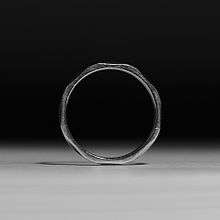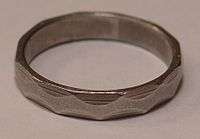Iron Ring


The Iron Ring is a ring worn by many Canadian-trained engineers, as a symbol and reminder of the obligations and ethics associated with their profession. From a concept originated in 1922,[1] the ring is presented to graduates in a closed ceremony known as The Ritual of the Calling of an Engineer,[2][3] developed with the assistance of English poet Rudyard Kipling.[2]
The ring symbolizes the pride which engineers have in their profession, while simultaneously reminding them of their humility. The ring serves as a reminder to the engineer and others of the engineer’s obligation to live by a high standard of professional conduct. It is not a symbol of qualification as an engineer – this is determined by the provincial and territorial licensing bodies.[4]
Material and design
The Iron Ring is made from either wrought iron or stainless steel.[5] The first ceremony awarding the ring was held in 1925, under the supervision of Herbert E. T. Haultain, professor of mining engineering at the University of Toronto.[3]
The rings are given in ceremonies held at individual universities, each assigned one of 26 camps of the Corporation of the Seven Wardens. Because iron deteriorates turning the finger black and making the ring fit more loosely all camps except Toronto, have stopped conferring rings made of iron and have switched to stainless steel rings. At the Toronto camp, the individual ceremonies held at the University of Toronto, Ryerson University, York University and the University of Ontario Institute of Technology, continue to provide recipients with a choice of rings made of wrought iron or stainless steel.
Many incorrectly believe that the rings are made from the steel of a beam from the first Quebec Bridge, which collapsed during construction in 1907. Seventy-five construction workers died in the collapse which was attributed to poor planning and design by the overseeing engineers.[6] Rudyard Kipling, who wrote the ritual obligation,[2] indicated that the Ring as an allegory in itself be rough, not smoothed, and hammered, and as a ring have no beginning nor end. There is no evidence that there is any particular history in the source of "Cold Iron" (from the Calling of the Engineer ceremony) for the Ring, nor any intention that there should have been. Remnants of the Quebec Bridge legend still exist in Canada.[3][5]
The Iron Ring is worn on the little finger ("pinky") of the working (dominant) hand.[5] There, the facets act as a sharp reminder of one's obligation while the engineer works, because it could drag on the writing surface while the engineer is drawing or writing. This is particularly true of recently obligated engineers, whose rings bear sharp, unworn, facets. Protocol dictates that the rings should be returned by retired engineers or by the families of deceased engineers. Some camps offer previously obligated or "experienced" rings, but they are now rare due to medical and practical complications.
The Ring itself is small and understated, designed as a constant reminder, rather than a piece of jewelry. The Rings were originally hammered manually with a rough outer surface. The modern machined ring design is unique, a reminder of the manual process. Twelve half-circle facets are carved into the top and bottom of the outer surface, with the two halves offset by one facet radius.
The Ritual of the Calling of an Engineer
The Ritual of the Calling of an Engineer is the ceremony where Iron Rings are given to graduating engineers who choose to obligate themselves to the highest professionalism and humility of their profession. It is a symbol that reflects the moral, ethical and professional commitment made by the engineer who wears the ring. The ceremonies are private affairs with no publicity. Invitations to attend are extended to local engineering alumni and professional engineers by those who are scheduled to participate. For some schools, the invitation to witness the ceremony is open to anyone in the engineering profession, and non-obligated engineers may not participate in the ritual. Some graduating engineers choose to receive a ring passed on from a relative or mentor, giving the ceremony a personal touch.
Adoption in the United States
.jpg)
Based upon the success of the Iron Ring in Canada, a similar program was created in the United States, where the Order of the Engineer[7] was founded in 1970. The organization conducts similar ring ceremonies at a number of U.S. colleges, in which the recipient signs an "Obligation of the Engineer"[8] and receives a stainless steel Engineer's Ring (which, unlike the Canadian Iron Ring, can be smooth and not faceted). The first such ceremony occurred on June 4, 1970, at the Cleveland State University under the supervision of Lloyd Chancy.[9]
See also
Notes
- ↑ Origin of the Iron Ring concept
- 1 2 3 "The Calling of an Engineer", The Corporation of the Seven Wardens, Retrieved November 17, 2012
- 1 2 3 Petroski 2012, p.187.
- ↑ https://www.camp1.ca/wordpress/?page_id=2
- 1 2 3 J. Jeswiet, "Information Relevant to the Iron Ring Ceremony", November 22, 2001; Retrieved November 22, 2012
- ↑ "The Iron Ring ", Engineer-in-Residence, Professional Engineers Ontario, Retrieved November 23, 2012
- ↑ "About The Order", Order of the Engineer, Retrieved November 23, 2012
- ↑ "Obligation of the Engineer", American Society of Civil Engineers; Retrieved November 16, 2012.
- ↑ Petroski 2012, p.175-198.
References
- Henry Petroski, "To Forgive Design: Understanding Failure" Cambridge, Mass: Belknap Press of Harvard University Press, 2012, ISBN 9780674065840. Chapter 8: "The obligation of an engineer", p. 175-198.
External links
![]() Media related to Iron Ring at Wikimedia Commons
Media related to Iron Ring at Wikimedia Commons